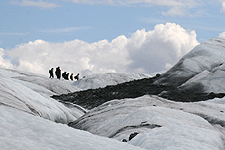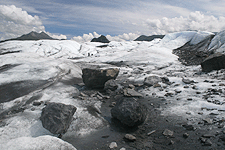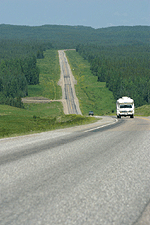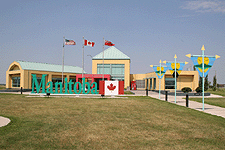Virtues Of The iPod
Now that I have talked about one of the devices (my GPS navigator) that make life on the road tolerable, I would like to mention another, the Apple iPod.
I was initially exposed to this little white box during a camping trip to Iowa. John, my technological friend, who knows a lot about cameras and other gadgets, pulled his out and started explaining what it does. (This harkens back to the days when we were comparing notes on our Apple Newtons, which I still adore.)
As with all new technology, the iPod didn't seem like a very big deal when it first made an appearance. "Yeah, it plays music", I thought. "So what?" I've got several Sony products that play cassettes and compact discs, plus a radio that works just fine.
Of course, it dawned on me while driving back home that I had a pile of cassettes and CDs floating around in the car. These were pretty bulky and inconvenience to handle. Also, my CD player was susceptible to bumps on the highway, always skipping when I went over a bridge, for example. I often had to set it on a towel.
As for cassettes, I had given up on music a long time ago. All my cassettes, now, were of audio books. These made long driving trips quite enjoyable.
The car radio had its problems. There was always the fact that stations would come in and out of reach as I would cruise from town to town. Almost as annoying was the selection, consisting mostly of Christian broadcasting, public radio, rap/hip-hop, country and western, and overplayed classic rock. None of these choices provided enjoyment for very long.
The idea of the iPod, or any digital music player, began to grow on me. If I could learn how to use one, I might be able to get rid of all my media clutter. No CDs or cassettes to fumble with, or potentially damage or misplace. Everything would be organized in one neat package, the unit's tiny hard drive.
Some time later, I was reintroduced to another person's iPod and discovered its shuffling feature. This is what finally sold me. I could put all my favorite music on this compact electronic player and it would randomly play selections. It was like the best radio station you could imagine. Without commercials, you would hear only the music you wanted to hear, and always be surprised.
So, I bought one. Shortly thereafter, I decided it was one of the best things I had ever bought in my life. At least in the top 5. It was extremely convenient and practical. Easy to use. No mess. Everything you want. Nothing you don't.
Once you own an iPod, you have to find things to place in it. At the time I purchased my unit, Pepsi was having an iPod promotion. You could look under the cap for a code, which you would then enter at Apple's iTunes Music Store. This would allow you to download one free song of your choosing. I got my first 50 songs this way.
Next, using the iTunes software on my computer, I began to convert all of my compact discs to mp3 files. Once in this format, songs could be easily transferred to the iPod's memory bank. Having done this, I was happy as a clam. I could ride around for hours and hear all of my albums, played in random order, with no repeats. I could also use the iPod's menu to narrow the playlist to include specific artists and genres.
As digital music players became more popular, additional forms of entertainment became available. Soon, audio books appeared on the web. At audible.com, I was able to purchase and download a number of books to my liking.
Most recently, so-called "podcasts" have become all the rage. These are digital audio and video segments that come from a variety of producers, both big and small. Again, I have gotten a number of these, for free, from the podcast section of the Apple iTunes Music Store. Other sources, such as Podcast Alley, are popping up as digital media distribution centers.
Podcasts are highly targeted forms of information. Many have to do with specific personal interests and hobbies. I personally enjoy ones on science and higher education. You can also find ones that discuss travel destinations, politics, health maintenance, and learning new languages. All sorts of stuff. Many radio and television programs are likewise being turned into audio podcast files.
I, myself, tend to travel alone. In such cases I would not recommend the iPod's new video capabilities, since they would be distracting. If you are traveling with a family, or other group, however, this might be just the thing. Both movies and popular television programs are available in the iPod format for a modest price.
Let me reiterate. Digital music players are a totally convenient way to store, organize and access music. They have the capability to hold and display a wide variety of content. The only hurdle these items have to overcome is the playback system.
If you are in a car, you are mostly limited to using an FM transmitter, one that will broadcast the sounds on your iPod to the car's radio. These often have difficulties, depending on the matchup between the transmitter and the car's radio receiver. I happen to drive a lot of rental cars and each one seems to have a unique personality regarding the radio system. Sometimes my iPod will play flawlessly. At other times, the signal is very intermittant. In the worst situations, listening can be quite frustrating. In the future, though, I see a trend to incorporate direct inputs for digital music players. This would eliminate the headaches.
Overall, my sleek little iPod has been my faithful traveling companion, eliminating everything I don't like about music on the road. I start my car, plug in the player and drive blissfully for the next 6 to 10 hours. What could be better?
I was initially exposed to this little white box during a camping trip to Iowa. John, my technological friend, who knows a lot about cameras and other gadgets, pulled his out and started explaining what it does. (This harkens back to the days when we were comparing notes on our Apple Newtons, which I still adore.)
As with all new technology, the iPod didn't seem like a very big deal when it first made an appearance. "Yeah, it plays music", I thought. "So what?" I've got several Sony products that play cassettes and compact discs, plus a radio that works just fine.
Of course, it dawned on me while driving back home that I had a pile of cassettes and CDs floating around in the car. These were pretty bulky and inconvenience to handle. Also, my CD player was susceptible to bumps on the highway, always skipping when I went over a bridge, for example. I often had to set it on a towel.
As for cassettes, I had given up on music a long time ago. All my cassettes, now, were of audio books. These made long driving trips quite enjoyable.
The car radio had its problems. There was always the fact that stations would come in and out of reach as I would cruise from town to town. Almost as annoying was the selection, consisting mostly of Christian broadcasting, public radio, rap/hip-hop, country and western, and overplayed classic rock. None of these choices provided enjoyment for very long.
The idea of the iPod, or any digital music player, began to grow on me. If I could learn how to use one, I might be able to get rid of all my media clutter. No CDs or cassettes to fumble with, or potentially damage or misplace. Everything would be organized in one neat package, the unit's tiny hard drive.
Some time later, I was reintroduced to another person's iPod and discovered its shuffling feature. This is what finally sold me. I could put all my favorite music on this compact electronic player and it would randomly play selections. It was like the best radio station you could imagine. Without commercials, you would hear only the music you wanted to hear, and always be surprised.
So, I bought one. Shortly thereafter, I decided it was one of the best things I had ever bought in my life. At least in the top 5. It was extremely convenient and practical. Easy to use. No mess. Everything you want. Nothing you don't.
Once you own an iPod, you have to find things to place in it. At the time I purchased my unit, Pepsi was having an iPod promotion. You could look under the cap for a code, which you would then enter at Apple's iTunes Music Store. This would allow you to download one free song of your choosing. I got my first 50 songs this way.
Next, using the iTunes software on my computer, I began to convert all of my compact discs to mp3 files. Once in this format, songs could be easily transferred to the iPod's memory bank. Having done this, I was happy as a clam. I could ride around for hours and hear all of my albums, played in random order, with no repeats. I could also use the iPod's menu to narrow the playlist to include specific artists and genres.
As digital music players became more popular, additional forms of entertainment became available. Soon, audio books appeared on the web. At audible.com, I was able to purchase and download a number of books to my liking.
Most recently, so-called "podcasts" have become all the rage. These are digital audio and video segments that come from a variety of producers, both big and small. Again, I have gotten a number of these, for free, from the podcast section of the Apple iTunes Music Store. Other sources, such as Podcast Alley, are popping up as digital media distribution centers.
Podcasts are highly targeted forms of information. Many have to do with specific personal interests and hobbies. I personally enjoy ones on science and higher education. You can also find ones that discuss travel destinations, politics, health maintenance, and learning new languages. All sorts of stuff. Many radio and television programs are likewise being turned into audio podcast files.
I, myself, tend to travel alone. In such cases I would not recommend the iPod's new video capabilities, since they would be distracting. If you are traveling with a family, or other group, however, this might be just the thing. Both movies and popular television programs are available in the iPod format for a modest price.
Let me reiterate. Digital music players are a totally convenient way to store, organize and access music. They have the capability to hold and display a wide variety of content. The only hurdle these items have to overcome is the playback system.
If you are in a car, you are mostly limited to using an FM transmitter, one that will broadcast the sounds on your iPod to the car's radio. These often have difficulties, depending on the matchup between the transmitter and the car's radio receiver. I happen to drive a lot of rental cars and each one seems to have a unique personality regarding the radio system. Sometimes my iPod will play flawlessly. At other times, the signal is very intermittant. In the worst situations, listening can be quite frustrating. In the future, though, I see a trend to incorporate direct inputs for digital music players. This would eliminate the headaches.
Overall, my sleek little iPod has been my faithful traveling companion, eliminating everything I don't like about music on the road. I start my car, plug in the player and drive blissfully for the next 6 to 10 hours. What could be better?




















































